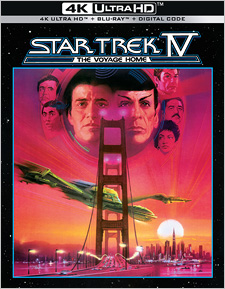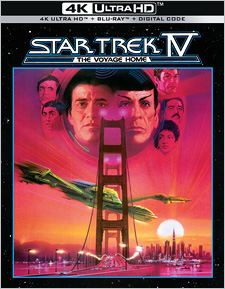Star Trek IV: The Voyage Home (4K UHD Review)

Director
Leonard NimoyRelease Date(s)
1986 (September 6, 2022)Studio(s)
Paramount Pictures (Paramount Pictures Home Entertainment)- Film/Program Grade: B+
- Video Grade: B+
- Audio Grade: B+
- Extras Grade: B
Review
Directed once again by series regular Leonard Nimoy, The Voyage Home is arguably the most accessible Star Trek film for non-fans, even as it relies upon one of the franchise’s most tried-but-true plot devices—time travel. Set immediately after the events of Star Trek III, it begins with Kirk and his crew preparing to return home from Vulcan to face the music with Starfleet for having stolen and destroyed Enterprise in their successful mission to save Spock.
But an alien probe is wreaking havoc back on Earth for reasons unknown, its strange signals causing damage to the planet’s atmosphere. En-route in their captured Klingon Bird-of-Prey, Kirk and company learn of this and make a discovery—the probe’s signals match the songs of humpback whales, which have been extinct for centuries due to human negligence. So our heroes formulate a desperate plan to travel back to Earth circa 1987 to find a pair of whales and then return with them so they can answer the probe’s call.
Not only is The Voyage Home the most popular entry in this film series, it’s also one of the more entertaining. Taking our heroes out of their usual 23rd Century context (and giving each of them something vital to do) actually makes them seem more human and engaging somehow. Watching Kirk and Spock attempting to fit in with the crowd in 1987 San Francisco is certainly worth a few good laughs. (“Oh yeah? Well a double dumb-ass on you!”). It would be difficult not to enjoy Scotty attempting to interact with late 20th Century computer technology, not to mention McCoy’s reaction to the state of the art in medicine during the period. And because of damage suffered during their time-warp, one of the film’s subplots involves Chekov and Uhura attempting to collect high-energy photons needed to repair the Bird-of-Prey’s engines—particles that can only be found in a “primitive” nuclear fission reactor. So they decide to sneak aboard a U.S. Navy aircraft carrier to get them... and naturally, it’s U.S.S. Enterprise. How can any self-respecting Star Trek fan not love that? What’s more, the film’s environmental message resonates more strongly today than ever before, given the present realities of climate change. And its opening dedication to the crew of the Space Shuttle Challenger still stirs the emotions of anyone who experienced that tragedy at the time.
Like the previous films in the series, Star Trek IV: The Voyage Home was shot on 35 mm photochemical film using Arriflex 35-III and Panavision Panaflex Gold cameras with Panavision C-Series and Super High Speed anamorphic lenses. Visual effects work was also completed using VistaVision, and the film was finished photochemically at the 2.39:1 aspect ratio. For its debut on Ultra HD, Paramount has completed a new 4K scan of the original camera negative and master interpositive elements to produce a new 4K Digital Intermediate, complete with color grading for High Dynamic Range (both HDR10 and Dolby Vision options are available). The resulting image is a dramatic improvement on the previous Blu-ray presentation, with a noticeable uptick in resolution. However the the film’s Bird-of-Prey interiors are dimly-lit and thicker with atmospherics (specifically, on set smoke) than we’ve seen in previous installments, resulting in a somewhat softer look in those scenes compared to the rest of the film. Image detail is very good, particularly in daylight exteriors that were shot on location throughout San Francisco, Monterey, Santa Ana, San Diego, and in the “Blue Sky Tank” on the Paramount lot. As is the case with the other 4K presentations in this set, the image is no longer plagued with DNR and there’s abundant film grain visible throughout. In several shots though—particularly some of those exterior locations, and possibly due to the use of a different camera while on location—the grain seems to be a little more coarse (and the compression appears to struggle with it just a bit). It’s not a significant issue, but it’s worth noting. The film’s palette is gorgeous though thanks to the wider-gamut of HDR, with richly-saturated colors and greater nuance in the various shadings. Shadows are deep and detailed, while the highlights are more naturally bright. The difference between Dolby Vision and HDR10 is very slight. On the whole, this is a fine 4K upgrade and a good looking image for a catalog film of this vintage.
Primary audio is included on the 4K disc in English 7.1 surround in lossless Dolby TrueHD format. This is the exact same mix found on the original 2009 Blu-ray. As is the case with the other films, while a new Dolby Atmos mix would have been welcome, the TrueHD was and remains quite good. The soundstage is medium-wide across the front, with pleasing use of the surround channels for music, ambient spatial effects, and occasional directional cues and panning (the pulsing signal of the probe itself is a highlight, along with the stormy weather on Earth, city sounds on the streets of San Francisco, and the ‘warp’ effects as the Bird-of-Prey travels through time). Dialogue is clean, bass is solid, and Leonard Rosenman’s score exhibits good fidelity. Optional audio mixes are available in German, Spanish, and French 2.0 stereo in Dolby Digital format, along with Japanese 5.1 surround in Dolby Digital. Subtitles are available in English, English for the Hearing Impaired, Danish, German, Spanish, French, Japanese, Dutch, Norwegian, Finnish, and Swedish.
Paramount’s new stand-alone 4K UHD release is a 2-disc set (UHD and Blu-ray) featuring the exact same discs found in the 2021 Star Trek: The Original 4-Movie Collection 4K set (reviewed here). Each disc offers a simple menu interface featuring the Bob Peak poster artwork for the film. The 4K disc includes the following special features:
- Commentary by William Shatner and Leonard Nimoy
- Commentary by Roberto Orci and Alex Kurtzman
Right off the bat, it should be said that the commentary with Nimoy and Shatner is one of the great bonus features that have ever been created for Star Trek. It’s not quite lively, but the pair has a genuine investment in these characters and this story, not to mention a shorthand with each other as actors, that makes this track an enjoyable listening experience. Unfortunately, longtime Trek fans may have a more difficult time listening to the second commentary with Orci and Kurtzman, given the direction the latter in particular has taken the franchise in recent years. Of all the people who deserved—and were well-suited—to becoming the Kevin Feige-like guiding hand of Star Trek (think Ronald Moore, Manny Coto, Nicholas Meyer, etc), Alex Kurtzman should never have been that guy. In any case, note that optional subtitles are available for the commentaries in English, German, Spanish, French, and Japanese.
The newly-remastered film is also offered in 1080p HD and SDR on a Blu-ray Disc that’s included in the packaging (and is also available separately). It features the exact same audio and subtitle options as the 4K disc and adds the following additional special features:
- Commentary by William Shatner and Leonard Nimoy
- Commentary by Roberto Orci and Alex Kurtzman
- Library Computer Viewing Mode (HD)
- Production
- Future’s Past: A Look Back (SD – 27:32)
- On Location (SD – 7:26)
- Dailies Deconstruction (SD – 4:13)
- Below-the-Line: Sound Design (SD – 11:45)
- Pavel Chekov’s Screen Moments (HD – 6:09)
- The Star Trek Universe
- Time Travel: The Art of the Possible (SD – 11:15)
- The Language of Whales (SD – 5:46)
- A Vulcan Primer (SD – 7:50)
- Kirk’s Women (SD – 8:19)
- Star Trek: The Three-Picture Saga (HD – 10:12)
- Star Trek for a Cause (HD – 5:40)
- Starfleet Academy SCISEC Brief 004: The Whale Probe (HD – 3:42)
- Visual Effects
- From Outer Space to the Ocean (SD – 14:43)
- The Bird-of-Prey (SD – 2:48)
- Original Interviews
- William Shatner (SD – 14:33)
- Leonard Nimoy (SD – 15:40)
- DeForest Kelley (SD – 13:02)
- Tributes
- Roddenberry Scrapbook (SD – 8:17)
- Featured Artist: Mark Lenard (SD – 12:44)
- Production Gallery (SD – 3:55)
- Storyboards (HD)
- Encounter with the Saratoga
- The Probe Approaches Earth
- Time Warp
- Mind Meld
- The Whaling Ship
- Return to the 23rd Century
- Communication
- NCC-1701-A
- Theatrical Trailer (HD – 2:24)
The rest of these extras are quite good, a bit more comprehensive than those for the other films, including vintage interviews with Shatner, Nimoy, and Kelley, another fine Library Computer viewing mode, and a pair of nice Tribute segments. The only extras that are not included here are the Okuda text commentary from the 2003 DVD and Roger Lay, Jr.’s The Dream Is Alive: The Continuing Mission featurette from the 2016 Star Trek: 50th Anniversary TV and Movie Collection’s bonus disc (so be sure to hang on to that if you have it). A Digital copy code is also included on a paper insert.
Star Trek IV: The Voyage Home is a great film, one that holds up just as well today as it did when it was first released in theaters back in 1986, and it’s arguably Leonard Nimoy’s finest effort as a director. Every member of the cast is given a chance to shine here, making this film a true ensemble work. The story is funny, engaging, and never loses its momentum. Perhaps most importantly, its optimistic message and idealism truly represents the Star Trek franchise at its very best. And the 4K upgrade is worth the purchase price for fans. Highly recommended.
- Bill Hunt
(You can follow Bill on social media at these links: Twitter and Facebook)

